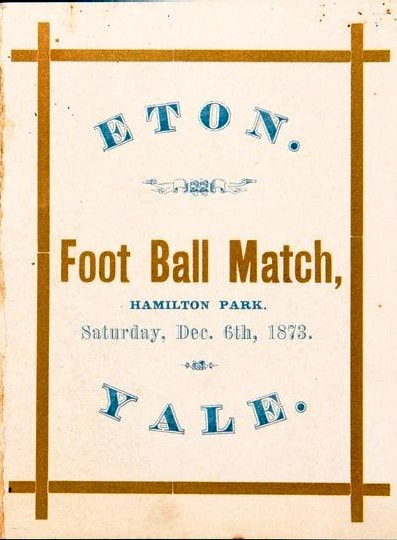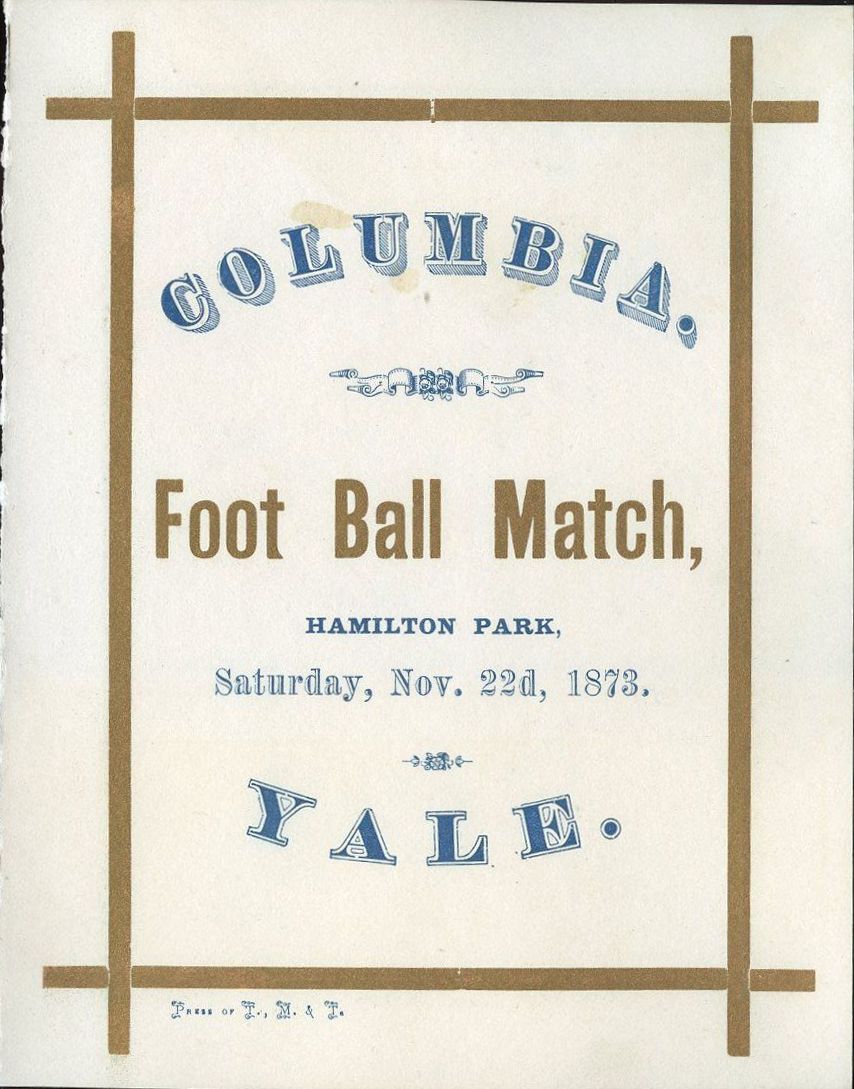The match has a significant place in sporting history as it was the first football contest, of any code, between a British team and one from another country.
This programme was sold last year for £15,000 by Graham Budd Auctions in London. His catalogue entry commented that 'the visiting team would have influenced the match to be played as faithfully as possible to Association Rules, as first codified and published by the Football Association in England in 1863.'
In fact, even though it was eleven-a-side and a kicking rather than carrying game, the rules were a kind of soccer hybrid which had been agreed two months earlier between representatives of Yale, Columbia, Princeton and Rutgers. They specified 20-a-side games, with goals 25 feet wide and a pitch 400 feet long, while the ball was a No 6 (the Football Association specified goals 8 yards wide, and a pitch up to 200 yards long, with a No 5 ball). The method of restarting the game after a foul or going out of play was bizarre: ‘the player so offending shall throw the ball perpendicularly into the air to a height of at least 12 feet and the ball shall not be in play until it has touched the ground.’
One of the Yale players, Clarence Deming, gave an account of the match in his book Yale Yesterdays, published in 1915: 'A number of young Englishmen, graduates of Eton, in business or traveling in this country, after seeing one of the intercollegiate games at Hamilton Park, proposed a game between Yale and old Etonians in the United States. The idea was welcomed at Yale, and after considerable discussion, the Yale rules were accepted with 'peanutting' left out, teams of eleven, and the match to be won or lost on actual results of games.'
This comment is important, as it confirms that Yale rules were applied, albeit with the traditional Eton number of eleven players. The term 'peanutting' is slang for offside.
Deming described the contrasting tactics: Eton massed behind the ball and tried to dribble it forward down the centre of the field, while Yale played the ball down the wings to create space. In the event, the weather had a major part in deciding the result, as all three goals in a 2-1 victory for Yale were scored with a gale at their backs; the sides changed ends after each goal. It might have lasted longer but the Etonians had to catch a train back to New York.
The Eton players (two did not attend the school) were listed by their initials, and it appears that a couple of errors crept in. I have researched their identities, and here is the full team:
George Cunard Allen (1848-1902), team captain. Eton 1860-66, now living in New York, partner in Bush & Jevons, merchants. Son of Major RSA Allen of Bath.
Philip Allen (1853-1903). Eton 1867-71. In business in New York, brother of above.
Gerald William (listed as JW) Balfour (1853-1945). Eton 1866-71, then Trinity College, Cambridge. MP 1885-1906, Chief Secretary for Ireland. Younger brother of AJ Balfour, son of JM Balfour of Whittinghame, East Lothian.
Constantine William Benson (1852-1905). Eton 1864-71 (Wall Eleven & Field Eleven), then Trinity College, Cambridge (Rowing blue). Partner in CW Benson, Bankers of Minnesota. Son of R Benson, merchant banker of London.
Ernest Chaplin (1849-1930). Harrow 1862-67, 'one of the best all round athletes'. Married Delene Morton in January 1874 in New York.
Edmund Smith Hanbury (1850-1913). Eton 1864-69 then Christ Church, Oxford. Son of RC Hanbury MP of Poles, Herts.
Robert Mure McKerrell (1846-1912). Eton 1859-63 then Trinity College, Cambridge. Of Hillhouse, Ayrshire and later Murrayfield, Edinburgh. Prison Commissioner for Scotland. A patron of St Mirren FC in the 1890s.
Hon Henry Romilly (1845-1886). Eton 1857-62 then Trinity College, Cambridge. Partner in Alfred Booth & Co, based in New York. Son of Lord Romilly, Master of the Rolls.
Robert Russell (1849-1876). Eton 1862-68 (Wall Eleven & Field Eleven), then Christ Church, Oxford. Accidentally killed in Abyssinia on a hunting expedition. Son of Captain R Russell of Bedale.
Viscount Tarbat (1852-93). Privately educated. Full name Francis Mackenzie Leveson-Gower, second son of the Duke of Sutherland. He was on a tour of USA 1873-74. Seaforth Highlanders.
Henry Meysey Meysey-Thompson (1845-1929). Eton 1858-64 (Cricket Eleven and athletics champion), then Trinity College, Cambridge (athletics blue). MP from 1880, intermittently. From 1905, he was Lord Knaresborough of Kirby Hall, Yorkshire. His brothers Albert and Charles won the FA Cup with Wanderers.
Further reading:
The Professional Football Researchers Association has a wide range of articles, notably No Christian End! about the early years of American college football and the evolving rules debate:
http://www.profootballresearchers.org/pfra-articles.htm
For more about early college programmes, see the Collectable Ivy website, which specializes in vintage American college football, and in particular their blogs about early programs:
https://collectableivy.wordpress.com/category/early-football-programs/
Graham Budd Auctions:
www.grahambuddauctions.co.uk






 RSS Feed
RSS Feed